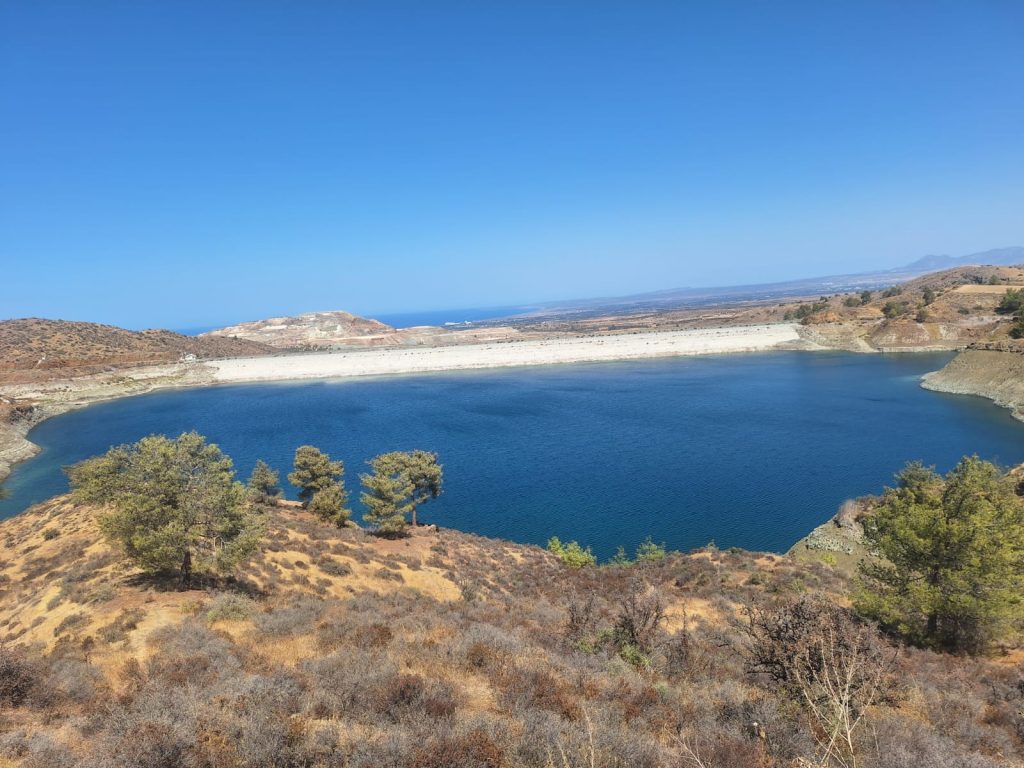Amid a crippling drought, the water in Solea reservoir is still under utilised
The story of Solea dam, while not exactly a huge scandal, is deeply frustrating, especially in the wake of last week’s audit office report laying out the water situation (more like water crisis) in Cyprus.
At a time when, according to the report, a total of 48.1 million cubic metres of water was effectively lost between 2021 and 2023 – a figure including water that was ‘lost’ to the public purse, i.e. not paid for – it’s frustrating to discover that there’s a sizeable quantity of water which, due to a combination of factors, is not being properly used.
The idea of building a dam in the Solea area, taking water from the Karkotis river in the northwestern foothills of Troodos, has been mooted ever since independence. The dam was finally built during the Christofias government, with a capacity of 4.5 million cubic metres – the 12th-biggest on the island, albeit a long way behind Kouris dam with its 115 million.
The project was completed in 2013 – but not entirely completed.
“All that remained was putting in the network of pipes so [the water] could run to the communities,” Panikos Hambas from the Union of Cypriot Farmers told the Cyprus Mail.
The network was installed for one community, the nearby village of Tembria – then nothing. “From that time till today, no government has moved forward on putting in pipes to provide the water in an organised way…. This has created many problems, and wasted a lot of water.”
How could this happen? How could the state spend millions on a project, do the hard work of constructing the dam, then leave out the final bit of connecting it to the communities? What’s the point of 4.5 million cubic metres of water – in a terrible drought, no less – if no-one can actually access it?
“Because, my friend, ‘This is Cyprus’,” says Hambas scathingly. “Name me one project that we’ve managed to complete. Just one! We built the dam, we celebrated, ‘Good for us, we built the dam’ – then the government that built it left office, and the new one put the brakes on it.”
That’s not entirely accurate, Monica Stylianou Andreou, Nicosia district engineer at the water development department, told the Cyprus Mail.
“The reason for the delay is because we’re having trouble with the routing of the pipes,” she explains. The original plan called for a land redistribution scheme, but it fell through – “so we’ve had to find solutions, passing the pipes through plots of land and along the borders”. This requires the owners’ consent, which is partly why it’s taken so long.
Locals admit this is true – but also point out that the hold-up isn’t because they’ve been refusing to give their consent. Rather, they claim, it’s because it took several years even for consent forms to be sent to them.
In any case, says Stylianou Andreou, it’s not like the water is being wasted.
“The water is being used – just not in the way it was originally planned. In other words, the permanent solution hasn’t been completed yet.”
To the government’s credit, it did come up with a temporary solution. In 2017 – after four years of the dam just sitting there – an arrangement was made to supply water, using existing irrigation ditches, to the area’s irrigation divisions, which would then channel it to farmers and extract payment.
There were (and are) two issues with this solution. The first is that ditches aren’t as efficient as water pipes would be.
“There’s a ditch two kilometres outside the village,” Leontios Leontiou from the irrigation division of Evrychou told the Cyprus Mail, “and the water comes to the village… About half of it gets lost, let’s say.”
The other, more important issue is that irrigation divisions are quite makeshift organisations, with limited duties. According to one farmer, his only previous contact with his local division was paying them €10 a month to clean out the irrigation ditches. They’re not really official bodies with power to impose wide-ranging sanctions.
“After all,” says Giorgos Kallouris from Linopsas, the irrigation division of the village of Linou, “why should I be doing the job of the water development department, and selling water?
“I’m just a farmer. I only joined the irrigation division because my crops were about to dry up – and I got into that whole mess, that whole hassle, having to supply water to everyone else too… Am I a government employee?”
There’s also a complicating factor in that very few professional farmers – only about a dozen – actually work in the area. Most plots are owned by people who live in the city, and use their fields (which they’ve mostly inherited) for olive or citrus groves. They’re bound to be less attached to the land than farmers who need it for their livelihood.
What exactly happened, and where the blame lies, is up for debate. Some producers used too much water, and neglected to pay. (After all, it was just a ‘temporary’ solution.) Those in charge of irrigation divisions didn’t press the case, or didn’t want to play policeman. The government, too, could’ve been more proactive, letting the situation escalate.
This is actually a surprisingly common problem, albeit made worse by the circumstances here. The audit office report found that 29.35 per cent of Cyprus’ water supply is supplied but not metred, therefore not paid for.
The water from Solea dam was certainly not metred, since the pipes hadn’t even been installed yet. There also seems to have been a general feeling that, since the state had neglected its obligations, land owners were justified in neglecting their own.
The upshot, after several years, was that locals owed thousands of euros – more than they could reasonably pay – in water dues. The government took them to court, and cut off the water supply in cases where the court found against them. At the moment, 12 years after Solea dam was built, some nearby villages (though not Linou or Evrychou) can’t access even a drop from it.
Both sides bear some responsibility, admits Hambas.
Still, he believes, the source of the trouble is that the dam wasn’t finished back in the day, forcing the adoption of wasteful and flawed back-up plans instead of the “organised irrigation network” which would’ve solved all the problems.
Meanwhile, having now obtained the owners’ consent for routing the pipes, the water development department is moving ahead with the third and final phase of the project, namely distributing the water to individual plots – though, due to lack of funds, the relevant study will be done by the private sector.
“We’re about to seek tenders for the study of the rest of the project,” says Stylianou Andreou, after which the competitive process to find a contractor will be carried out as soon as possible.
“The minister – when we saw her in the past year – promised that the Solea dam would be a priority,” Athina Georgiou, president of Linou community council, told the Cyprus Mail.
That’s quite encouraging. Then again, building a dam in Solea has been a priority for several decades now.

